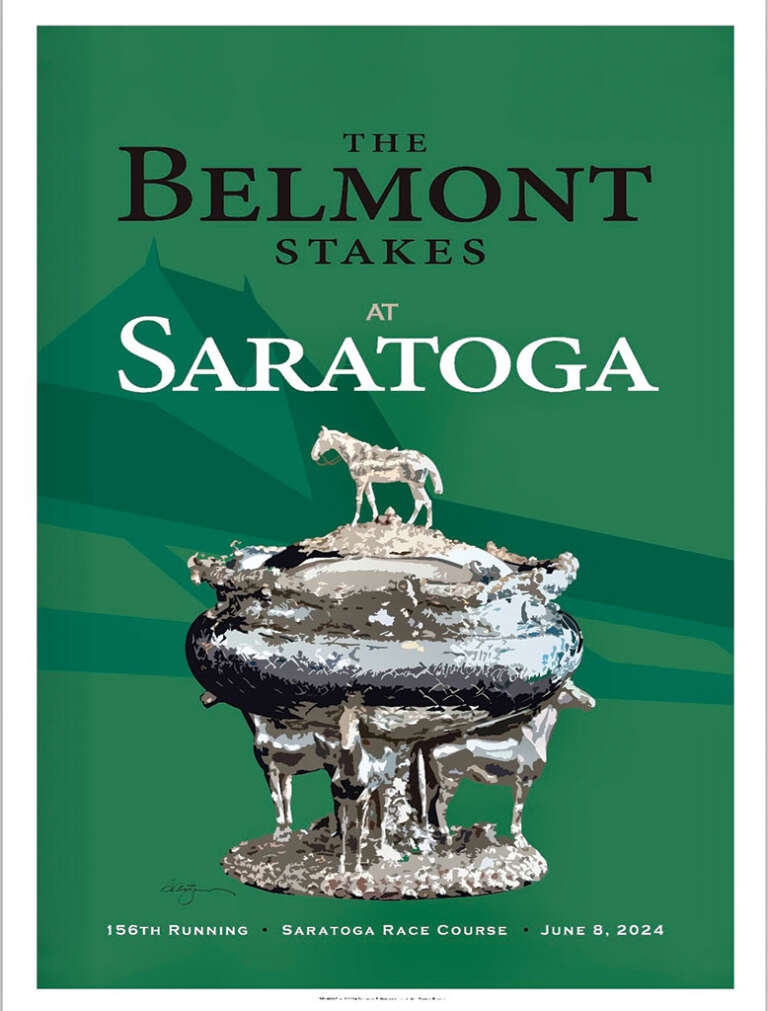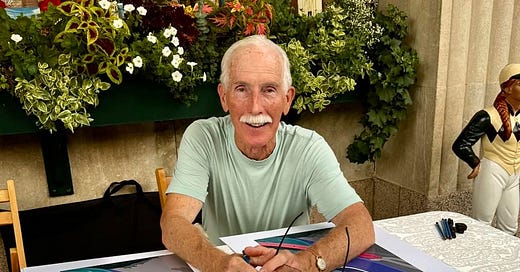Celeb Shot: Greg Montgomery
How an artist from Washington, DC came to create nearly 40 posters commemorating the biggest day in Saratoga racing: the Travers.

Every spring, I meet with Brien Bouyea, the National Museum of Racing and Hall of Fame’s communications director, to talk about the content for that summer’s track issue. Brien always comes to me with plenty of ideas for stories that should go in our biggest edition of the year, and, more often than not, one of them is about Greg Montgomery. Before I knew Greg, the artist responsible for the iconic, 39-year-long Travers poster series, I thought it was a little overkill. A story about a poster every year? How interesting can this guy be?
Turns out, incredibly interesting.
Since hearing Greg give a talk about his 2022 “Breakfast at the Track” poster, I can’t get enough of his signature mix of child-like wonder and unceasing humility. The passion with which he talks about what goes into each individual poster is infectious, as is his gratitude for the fact that he wound up working in a city as vibrant as Saratoga Springs. Earlier this year I sat down with Greg to talk about what he was doing for the Belmont (he was doing a lot), and ended up talking with him for more than an hour. At the time, he was mere days away from heading off on a three-month European adventure, during which he’d serve as an artist in residence at the American College of the Mediterranean in Aix-en-Provence, France. I vowed to catch back up with him when he returned to Saratoga, and did so just in time for this afternoon’s 155th running of the Travers Stakes.

Fresh off a stint as a lecturer oversees, Greg is the type of interviewee that doesn’t really require questions to get him started on any number of enlightening monologues, but he humored me anyway.
What were you doing over in France?
I gave lectures on the history of the poster (which, by the way, started in France), on my own posters and how I do them, and on the business of art and what you need to know to actually make a living with a paintbrush. It was so fun. The students were brilliant and they asked really hard questions, but I was absolutely delighted to be there. Then I traveled extensively all over France. I had my family come visit me, including my 10-month-old granddaughter. I was in Paris for a week just before the Olympics.
You finished your Belmont poster before you left for France. What happened while you were gone?
I printed 500 copies, and that’s a lot. I signed them all, and delivered them to stores around town in February. I said to each of the store owners, “Listen, I just want you to have enough. If you don’t sell these, I’ll take them back and we’ll settle up.” Well, every single one of them ran out of posters. It’s the first time that’s ever happened. I’m in Paris, and I get calls from not one but four people saying, “We don’t have any posters.” So for the first time in my life, I called my printer and said, “You’re not going to believe it, but I need more posters.” I had them print a lot more, and the day I got home—June 1—I landed at JFK, drove to Troy, picked them up, signed them and the next day delivered them all over Saratoga. And you know what? They sold out. I’ve never seen anything like the Belmont. It was a delight to be a part of that.

Let’s back up a bit. Tell me how you got to this point in your life.
I should start all this off by saying I think I’m one of the luckiest people I’ve ever met. So, knowing that, here we go: I was born in Washington, DC and raised in Maryland. There was never a time I couldn’t look at something and draw it. When I was young, everybody thought that was pretty amazing. The older I got, the less people thought it was amazing. I went off to the University of New Mexico because my grandparents lived there and my brother before me went there and really liked it. I met a beautiful, wonderful human, Eileen, and married her. After many years of living in Albuquerque with my bride, I got a job with General Electric and we moved to Saratoga and I worked at GE as an art director. Someone said if I wanted to go back to school and work on my master’s, GE would help pay for it. So I went to Saint Rose.
And what happened there?
I majored in screen printing, and it came to pass that in the very first semester, the very first project was to design and print a poster. I was in Saratoga walking down Broadway and I walked into what was then Dayspring Gallery. On my way out the door, I saw a small 8.5-by-11 notice scotch-taped to the front door that said something about the Travers. And I said, “What’s this here?” Jack, the owner, goes, “Oh my god, it’s just the most important thing to ever happen!” I said, “No offense, but if it’s that wonderful, how come it’s got this little piece of paper stuck to the door? Wouldn’t you think it would have a poster?”

How did you come up with the design for that first poster?
One of the things Jack said was that the Travers is American racing royalty. I got to thinking that the silks represent individual families, and they got to looking like coats of arms to me. I thought, you know what I’m going to do? I’m going to do a poster that has all the winners of the Travers. This was before I found out that there were, like, 130 winners of the Travers. Some sweet person at the Museum of Racing, where I went for advice, looked at me and after they figured out that I wasn’t kidding they said, “That’s not a poster—that’s wallpaper.” So they helped me pick horses and families that couldn’t be left out. I did sketches of all the silks at the Museum of Racing, and brought them back to my studio. I stuck them on a board and went to the other side of the room to see how they looked. I decided that three across, five down looked really cool. And I never for a second thought about the fact that I was making something that was unframeable at 17 by 33 inches. The only people who have ever truly loved me are the people who frame my work, because you can’t buy a standard frame.
And it just took off from there?
Year after year, folks liked the posters and then eventually got used to them. The year that I didn’t do one, I was so surprised that everybody a.) noticed and b.) got pissed. So the next year, instead of doing just one poster, I did two to fill in the gap.

Why do you think the posters are so popular?
I discovered that a poster is truly just a piece of paper until someone buys it. When they buy it, there’s a reason they bought it. The reason is that that was the year Uncle Harry hit the trifecta, or it was the year Sally met Fred. It really stops being about whatever’s on the poster when they hang it in their homes. It becomes the year that Kenny was born.
Tell us about this year’s Travers poster.
Last year, in the process of deciding what the poster would be, I had a conversation with the people in France. They said, “Your work is beautiful and it does an incredible job of highlighting this amazing city—Saratoga—but it’s so specific. Do you have any artwork that would be more international in nature?” And I said, “I don’t now but I will soon.” I wanted to go back to something that talks about the industry, not the place. I wanted something that could just as easily say “Ascot” at the bottom. I wanted something that speaks to a larger audience—that’s going to hang in a house. Maybe you’ll see it in Paris. That’s what this artwork is. It’s called “Race Ready” and it’s the throne in the Sport of Kings.

What do you have in store for next year’s 40th poster?
I started with the silks in 1986, so 40 years later I’m going to do another one with all-new silks. The National Museum of Racing is going to create an exhibit for me. It opens on June the 4th, which is Belmont Week. I can’t even imagine what that’s going to be like.
You’ve done work beyond the Travers poster series, right?
Spa Fine Art is the place where my fine art is. There are horses in there, but it’s mostly beautiful women…What can I say? The most popular piece I have ever done in my life is called “Saratoga Benches.” It’s a woman in a black dress and a yellow hat. That woman is my second wife, Paula, who died two years ago. We both worked for General Electric back in the ’80s, and when Neutron Jack Welch had us all laid off, we had to go form our own companies because we no longer had a job. I needed someone that actually answered emails—a grownup. And that’s who Paula was. We were business partners. She was the brains of the outfit. Twenty-two years after being divorced, I married her. She was my muse, my model, my everything for over 40 years.

Will you be signing posters around town this weekend?
I have a poster signing at the Racing Museum from 9-11am on Saturday and then later that night at Spa Fine Art from 7-9pm, but It’s usually 10:30 or 11 by the time I get out of there. It’s one of the best times I have all year. On Sunday, I usually sit home and recover, but this year I’m going to Impressions and I’m going to sign on the sidewalk from 11am to probably 1 or 2pm.
Will you have time in between to get to the Travers?
I’ll be at the Museum in the morning and then I’ll take myself over to the track. I’ll wander around and take pictures of everybody and see what I can see. It’s just such an incredible place to be. It’s astonishing to me that I ended up in Saratoga. I could’ve ended up in some lovely town that doesn’t have one of the top tracks in the world. And then what would’ve happened? I wouldn’t have done a poster series. I’m just incredibly fortunate.
—Natalie



